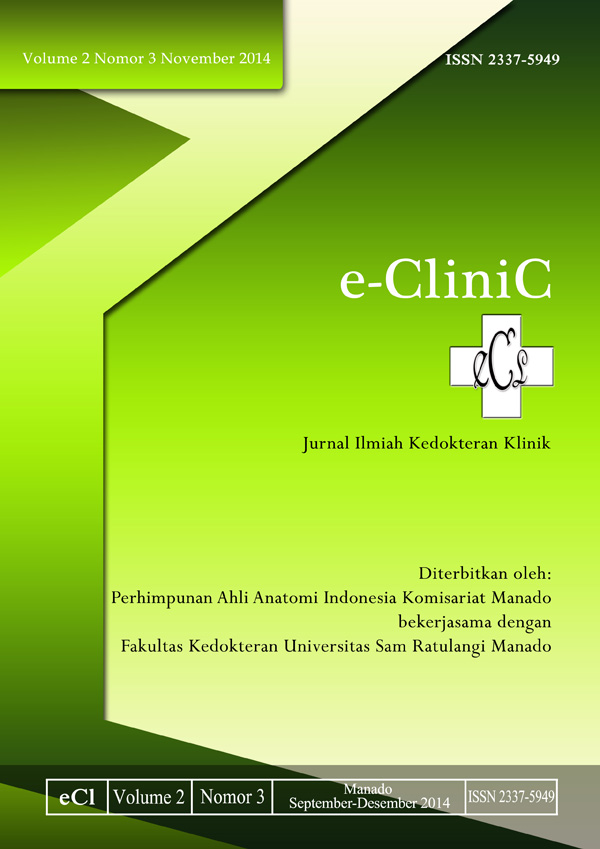HUBUNGAN ANTARA STRES DENGAN POLA MENSTRUASI PADA MAHASISWI FAKULTAS KEDOKTERAN UNIVERSITAS SAM RATULANGI MANADO ANGKATAN 2010
DOI:
https://doi.org/10.35790/ecl.v2i3.5759Abstract
Abstract: Adolescence is a period that very sensitive and vulnerable to stress that caused by more rapid physical maturation process than the psychosocial maturation. Stress involves the neuroendocrinology system as a system that has a large role in the female reproduction and therefore contributes to menstrual pattern. Ongoing stress can lead to depression. The prevalence of stress on women is 2 times higher than man. This research aims to determine whether there is a correlation between stress and menstrual pattern on female college student in Medical Faculty 2010 of Sam Ratulangi University Manado. Methods: Design of this research is using analytical observational methods with cross sectional approach. The sampling technique that used is total sampling and 90 respondents that appropriate with the specified criteria and the collecting data technique is using DASS 42 questionnaires. Results: Data obtained most about stress level characteristics is at the normal group which is 54 respondents (60 %) and the fewest is at very severe stress group which is 2 respondents (2,2 %). Data on the characteristics of menstrual cycle, respondents that obtained in regular category is 69 respondents (76,7 %) and in negative category is 21 respondents (23,3,%). Conclusion: There is a correlation between stress level and menstrual cycle on the female college student in Medical Faculty 2010 of Sam Ratulangi University Manado. It is proved by the result of the research which is obtained that most of respondents had a normal stress level with the number of 54 respondents (60 %) and most of respondents had regular menstrual cycle with the number of 69 respondents (76,7 %).
Keywords : Stress, menstrual cycle.
Â
Â
Abstrak: Masa remaja merupakan masa sangat sensitif dan rawan terhadap stres yang disebabkan proses pematangan fisiknya lebih cepat dari pematangan psikososial. Stres melibatkan sistem neuroendokrinologi sebagai sistem yang besar peranannya dalam reproduksi wanita sehingga berpengaruh terhadap pola menstruasi.Stres yang berkelanjutan dapat menyebabkan depresi.Prevalensi depresi pada wanita 2 kali lebih tinggi dibanding pria.Penelitian ini bertujuan untuk mengetahui ada tidaknya hubungan antara stres dengan pola menstruasi pada mahasiswi Fakultas Kedokteran Universitas Sam Ratulangi Manado Angkatan 2010. Metode: Desain penelitian menggunakan metode obsevasional analitik dengan pendekatan cross sectional. Teknik sampling yang digunakan adalah total sampling dan 90 responden yang sesuai dengan kriteria yang ditentukan dan teknik pengumpulan data menggunakan kuesioner DASS 42. Hasil: Data didapatkan paling banyak mengenai karakteristik tingkat stress yaitu pada kelompok normal sebanyak 54 responden (60%) dan paling sedikit pada kelompok stress sangat parah 2 responden (2,2%). Data mengenai karakteristik siklus haid, responden penelitian didapatkan pada kategori teratur dengan jumlah 69 responden (76,7%) dan pada ketegori negatif 21 responden (23,3%). Simpulan: Terdapat hubungan antara tingkat stres dengan siklus haid pada mahasiswi Fakultas Kedokteran Universitas Sam ratulangi Manado.Dibuktikan dengan hasil penelitian dimana terdapat sebagian besar responden mengalami tingkat stres normal dengan jumlah 54 responden (60%) dan sebagian besar responden mengalami siklus haid teratur dengan jumlah 69 responden (76,7%).
Kata kunci: Stres, pola menstruasi.
Downloads
How to Cite
Issue
Section
License
COPYRIGHT
Authors who publish with this journal agree to the following terms:
Authors hold their copyright and grant this journal the privilege of first publication, with the work simultaneously licensed under a Creative Commons Attribution License that permits others to impart the work with an acknowledgment of the work's origin and initial publication by this journal.
Authors can enter into separate or additional contractual arrangements for the non-exclusive distribution of the journal's published version of the work (for example, post it to an institutional repository or publish it in a book), with an acknowledgment of its underlying publication in this journal.
Authors are permitted and encouraged to post their work online (for example, in institutional repositories or on their website) as it can lead to productive exchanges, as well as earlier and greater citation of the published work (See The Effect of Open Access).







